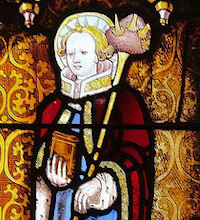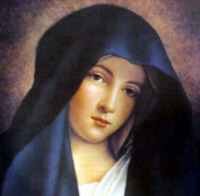Ordinary Time: September 15th
Memorial of Our Lady of Sorrows
Old Calendar: Seven Sorrows of the Blessed Virgin Mary; St. Nicomedes, martyr; St. Catherine of Genoa, widow (Hist) ; Other Titles: Seven Sorrows of the Blessed Virgin Mary; Our Lady of Seven Dolours; Our Lady of Dolours
Devotion to the Seven Sorrows of Our Lady has its roots in Sacred Scripture and in Christian piety, which always associates the Blessed Mother with her suffering Son. Today's feast was introduced by the Servites in order to intensify devotion to Our Lady's Sorrows. In 1817 Pius VII — suffering grievously in exile but finally liberated by Mary's intercession — extended the feast to the universal Church.
According to the 1962 Missal of St. John XXIII the Extraordinary Form of the Roman Rite, today is the feast of St. Nicomedes, a Roman martyr of unknown date. He was buried not far from the walls of Rome on the Via Nomentana, and the pious faithful built a "cemetery basilica" above his tomb. Also it is the feast of St. Catherine of Genoa who wrote a treatise on Purgatory and a Dialogue between the soul and body—two outstanding documents of Christian mysticism.
Our Lady of Sorrows This feast dates back to the 12th century. It was especially promoted by the Cistercians and the Servites, so much so that in the 14th and 15th centuries it was widely celebrated throughout the Catholic Church. In 1482 the feast was added to the Missal under the title of "Our Lady of Compassion." Pope Benedict XIII added it to the Roman Calendar in 1727 on the Friday before Palm Sunday. In 1913, Pope Pius X fixed the date on September 15. The title "Our Lady of Sorrows" focuses on Mary's intense suffering during the passion and death of Christ. "The Seven Dolors," the title by which it was celebrated in the 17th century, referred to the seven swords that pierced the Heart of Mary. The feast is like an octave for the birthday of Our Lady on September 8th.
This feast dates back to the 12th century. It was especially promoted by the Cistercians and the Servites, so much so that in the 14th and 15th centuries it was widely celebrated throughout the Catholic Church. In 1482 the feast was added to the Missal under the title of "Our Lady of Compassion." Pope Benedict XIII added it to the Roman Calendar in 1727 on the Friday before Palm Sunday. In 1913, Pope Pius X fixed the date on September 15. The title "Our Lady of Sorrows" focuses on Mary's intense suffering during the passion and death of Christ. "The Seven Dolors," the title by which it was celebrated in the 17th century, referred to the seven swords that pierced the Heart of Mary. The feast is like an octave for the birthday of Our Lady on September 8th.
—Excerpted from Our Lady of Sorrows by Fr. Paul Haffner (Inside the Vatican, September 2004)
This feast is dedicated to the spiritual martyrdom of Mary, Mother of God, and her compassion with the sufferings of her Divine Son, Jesus. In her suffering as co-redeemer, she reminds us of the tremendous evil of sin and shows us the way of true repentance. May the numerous tears of the Mother of God be conducive to our salvation; with which tears Thou, O God, art able to wash away the sins of the whole world.
As Mary stood at the foot of the Cross on which Jesus hung, the sword of sorrow Simeon had foretold pierced her soul. Below are the seven sorrows of Mary:
- The prophecy of Simeon (Luke 2:25-35)
- The flight into Egypt (Matthew 2:13-15)
- Loss of the Child Jesus for three days (Luke 2:41-50)
- Mary meets Jesus on his way to Calvary (Luke 23:27-31; John 19:17)
- Crucifixion and Death of Jesus (John 19:25-30)
- The body of Jesus being taken from the Cross (Psalm 130; Luke 23:50-54; John 19:31-37)
- The burial of Jesus (Isaiah 53:8; Luke 23:50-56; John 19:38-42; Mark 15:40-47)
Symbols: heart pierced with a sword; heart pierced by seven swords; winged heart pierced with a sword; flowers: red rose, iris (meaning: "sword-lily"), cyclamen.
Patron: people named Dolores, Dolais, Deloris, Dolorita, Maria Dolorosa, Pia, and Pieta.
Things to Do:
- Teach your children the Seven Sorrows of Mary. Read more about this devotion. September is traditionally dedicated to Our Lady of Sorrows.
- Present different art pieces of Our Lady of Sorrows, or illustration of one of her sorrows, for meditation and discussion. There are so many different pieces from all different eras, countries and mediums. Search words for art titles would be Lamentation, Deposition, Pieta, Dolorosa, Sorrows, etc. Some samples:
- The Seven Sorrows of the Virgin by Albrecht Durer
- Michelangelo's Pieta
- Pieta by Giovanni Bellini
- Vincent Van Gogh's Pieta
- Titian's Mater Dolorosa
- Different artists on the Presentation in the Temple
- Various artists on the Flight into Egypt
- The Seven Sorrows of the Virgin by Albrecht Durer
- Discuss why Mary is called the Queen of Martyrs.
- Make a heart-shaped cake for dessert, decorated with the swords piercing the heart.
- Think of ways to make reparation to Mary for the sins committed against Our Lord.
- Pray the short prayer or ejaculation, Holy Mother, imprint deeply upon my heart the wounds of the Crucified.
- Read or sing the Stabat Mater, perhaps incorporating it with the Stations of the Cross.
- In Italy, the title of Our Lady of Sorrows is Maria Santissima Addolorata. This devotion began in the 1200s. She is the patron of many Italian cities. In southern Italy there is La Festa della Madonna dei Sette Dolori (the festival of the Seven Sorrows of the Madonna), instituted in 1423, also called Madonna dell’Addolorata Festival. The food connected to this festival is cuccia salata, wheat berries cooked in meat broth and layered with goat or pork.
St. Nicomedes St. Nicomedes was a martyr of unknown era. The Roman Martyrologium and the historical Martyrologies of Bede and his imitators place the feast on this date. The Gregorian Sacramentary contains under the same date the orations for his Mass . The name does not appear in the three oldest and most important manuscripts of the "Martyrologium Hieronymianum", but was inserted in later recensions ("Martyrol. Hieronymianum", ed. De Rossi-Duchesne, in Acta SS., Nov., II, 121). The saint is without doubt a martyr of the Roman Church. He was buried in a catacomb on the Via Nomentana near the gate of that name. Three seventh century Itineraries make explicit reference to his grave, and Pope Adrian I restored the church built over it (De Rossi, "Rome Sotterranea", I, 178-79). A titular church of Rome, mentioned in the fifth century, was dedicated to him (titulus S. Nicomedis). Nothing is known of the circumstances of his death. The legend of the martyrdom of Sts. Nereus and Achilleus introduces him as a presbyter and places his death at the end of the first century. Other recensions of the martyrdom of St. Nicomedes ascribe the sentence of death to the Emperor Maximinianus (beginning of the fourth century).
St. Nicomedes was a martyr of unknown era. The Roman Martyrologium and the historical Martyrologies of Bede and his imitators place the feast on this date. The Gregorian Sacramentary contains under the same date the orations for his Mass . The name does not appear in the three oldest and most important manuscripts of the "Martyrologium Hieronymianum", but was inserted in later recensions ("Martyrol. Hieronymianum", ed. De Rossi-Duchesne, in Acta SS., Nov., II, 121). The saint is without doubt a martyr of the Roman Church. He was buried in a catacomb on the Via Nomentana near the gate of that name. Three seventh century Itineraries make explicit reference to his grave, and Pope Adrian I restored the church built over it (De Rossi, "Rome Sotterranea", I, 178-79). A titular church of Rome, mentioned in the fifth century, was dedicated to him (titulus S. Nicomedis). Nothing is known of the circumstances of his death. The legend of the martyrdom of Sts. Nereus and Achilleus introduces him as a presbyter and places his death at the end of the first century. Other recensions of the martyrdom of St. Nicomedes ascribe the sentence of death to the Emperor Maximinianus (beginning of the fourth century).
Excerpted from the Catholic Encyclopedia
St. Catherine of Genoa St. Catherine was noble in birth, rich, and exceedingly beautiful. As a child she rejected the solicitations of the world, and begged her divine Master for some share in His sufferings. At sixteen years of age she found herself promised in marriage to a young nobleman of dissolute habits, who treated her with such harshness that, after five years, wearied out by his cruelty, she somewhat relaxed the strictness of her life and entered into the worldly society of Genoa. At length, enlightened by divine grace as to the danger of her state, she resolutely broke with the world and gave herself up to a life of rigorous penance and prayer. The charity with which she devoted herself to the service of the hospitals, undertaking the vilest of offices with joy, induced her husband to amend his evil ways and he died penitent. Her heroic fortitude was sustained by the constant thought of the Holy Souls, whose sufferings were revealed to her, and whose state she has described in a treatise full of heavenly wisdom. A long and grievous malady during the last years of her life only served to perfect her union with God, till, worn out in body and purified in soul, she breathed her last on September 14, 1510.
St. Catherine was noble in birth, rich, and exceedingly beautiful. As a child she rejected the solicitations of the world, and begged her divine Master for some share in His sufferings. At sixteen years of age she found herself promised in marriage to a young nobleman of dissolute habits, who treated her with such harshness that, after five years, wearied out by his cruelty, she somewhat relaxed the strictness of her life and entered into the worldly society of Genoa. At length, enlightened by divine grace as to the danger of her state, she resolutely broke with the world and gave herself up to a life of rigorous penance and prayer. The charity with which she devoted herself to the service of the hospitals, undertaking the vilest of offices with joy, induced her husband to amend his evil ways and he died penitent. Her heroic fortitude was sustained by the constant thought of the Holy Souls, whose sufferings were revealed to her, and whose state she has described in a treatise full of heavenly wisdom. A long and grievous malady during the last years of her life only served to perfect her union with God, till, worn out in body and purified in soul, she breathed her last on September 14, 1510.
Excerpted from Butler's Lives of the Saints
Patron: Brides, Childless People, Difficult Marriages, People Ridiculed For Their Piety, Temptations, Victims Of Adultery, Victims Of Unfaithfulness, Widows.
Things to Do:
- Read St. Catherine's Treatise on Purgatory and the Life and Doctrine of Catherine of Genoa.
